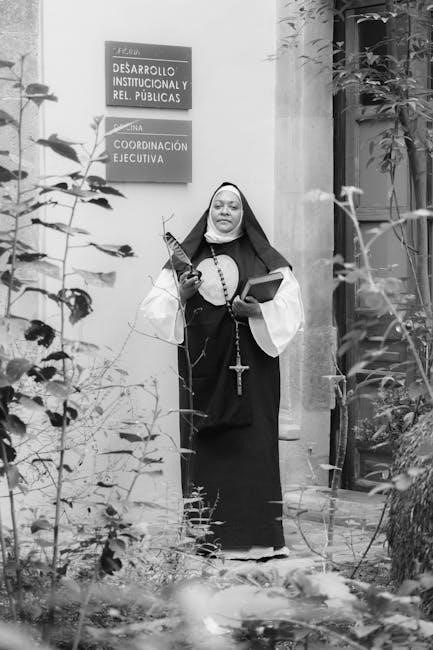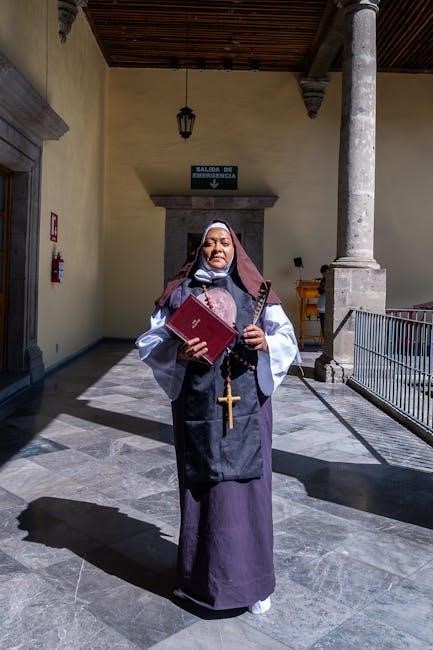The Rosary in Latin is a timeless Catholic devotion, offering a universal and profound way to connect with faith through traditional prayers and mysteries.
What is the Rosary?
The Rosary is a sacred Catholic devotion, a prayerful meditation on the life of Christ and the Virgin Mary, using a set of beads to guide the prayers. It consists of 15 decades, divided into three sets of five mysteries each, reflecting key events in salvation history. The Dominican Rosary is the most common form, but other variations exist, such as the Franciscan Rosary and the Rosary of the Seven Sorrows. Each decade includes the Our Father, Hail Mary, and Glory Be prayers, creating a rhythm of praise and contemplation. Praying the Rosary in Latin connects believers to the Church’s rich tradition and universal heritage, emphasizing unity and timelessness in worship;
Importance of Praying in Latin
Praying the Rosary in Latin connects believers to the universal and timeless tradition of the Catholic Church, emphasizing the sacred and unchanging nature of faith. Latin, as the Church’s official language, bridges cultural and linguistic divides, fostering unity among the global faithful. It also deepens spiritual connection by engaging with prayers in their original, reverence-evoking form. The Latin text of the Rosary, such as the Ave Maria and Pater Noster, reflects the rich theological and liturgical heritage of Christianity. By praying in Latin, one participates in a tradition shared by generations, fostering a sense of continuity and devotion. This practice enhances meditation and contemplation, drawing believers closer to the mysteries of Christ and Mary.

Structure of the Rosary
The Rosary is traditionally structured as the Dominican Rosary, with 15 decades divided into three sets of five. Other forms include the Franciscan Rosary and the Rosary of the Seven Sorrows.
The Dominican Rosary
The Dominican Rosary, the most commonly known form, consists of 15 decades divided into three sets of five. Each decade includes an Our Father and ten Hail Marys, with a Glory Be concluding each set. The prayers are often recited in Latin, preserving the traditional and universal nature of the devotion. This structure allows for deep meditation on the mysteries of the Rosary, fostering a profound spiritual connection. The Dominican Rosary is a cornerstone of Catholic prayer, offering a structured yet flexible method for devotion and reflection. Its timeless design has made it a beloved practice for millions worldwide.
Other Forms of the Rosary
Beyond the Dominican Rosary, there are various other forms, each with unique characteristics. The Franciscan Rosary, for instance, emphasizes the Seven Joys of Mary, while the Rosary of the Seven Sorrows focuses on the dolorous events in Mary’s life. The Brigittine Rosary, another variation, consists of 63 beads, honoring the 63 years of Mary’s life. These diverse forms allow devotees to explore different spiritual dimensions, catering to individual preferences and devotional needs. Each form, while distinct, shares the common thread of prayerful meditation rooted in Catholic tradition. This variety ensures the Rosary remains a versatile and inclusive devotion for all.

Prayers of the Rosary in Latin
The Rosary in Latin includes traditional prayers like the Sign of the Cross, Apostles’ Creed, Our Father, Hail Mary, and Glory Be, offered in their classic Latin forms for devotion and reflection.
Sign of the Cross (Signum Crucis)
The Sign of the Cross is the opening prayer of the Rosary, invoking the Holy Trinity. It begins with the Latin words: In nómine Patris, et Fílii, et Spíritus Sancti. Amen. This gesture symbolizes the Christian’s devotion to the Father, Son, and Holy Spirit, while also serving as a protective sign. It is a powerful reminder of the sacrificial love of Christ and unites the faithful in a common act of worship. The Sign of the Cross is not just a prayer but a profound expression of faith, preparing the heart for the mysteries of the Rosary and the intercession of the Blessed Virgin Mary.
Apostles’ Creed (Symbolum Apostolorum)
The Apostles’ Creed is a foundational prayer recited after the Sign of the Cross in the Latin Rosary. It begins with the Latin words: Credo in Deum Patrem omnipoténtem, Creatórem cæli et terræ. This prayer professes the core beliefs of Christianity, including the Trinity, the Incarnation, and the Resurrection. It is a concise summary of the Catholic faith, emphasizing the divine nature of Jesus Christ and the mysteries of salvation. The Creed serves as a unifying declaration, reinforcing the believer’s commitment to the teachings of the Church. Its recitation during the Rosary prepares the heart for meditation on the sacred mysteries, deepening devotion to Christ and His redemptive work.
Our Father (Pater Noster)
The Our Father (Pater Noster) is a central prayer of the Rosary, taught by Jesus Himself. In Latin, it begins: Pater noster, qui es in cælis, sanctificétur nomen tuum. This prayer expresses profound themes, including the sanctification of God’s name, the fulfillment of His will, and the request for daily bread. It also emphasizes forgiveness and protection from temptation. Recited after the Apostles’ Creed, the Our Father introduces each decade of the Rosary, setting a meditative tone for contemplating the mysteries. Its universal appeal lies in its simplicity and depth, making it a cornerstone of Christian devotion and a unifying element in the Latin Rosary tradition.
Hail Mary (Ave Maria)
The Hail Mary (Ave Maria) is a foundational prayer of the Rosary, honoring the Blessed Virgin Mary. In Latin, it begins: Ave María, grátia pléna, Dóminus tecum. This prayer combines biblical greetings from the Angel Gabriel and St. Elizabeth, expressing reverence for Mary’s divine motherhood. The second part petitions Mary’s intercession, seeking her prayers for sinners. Recited after the Pater Noster, the Ave Maria is repeated ten times per decade, fostering a meditative rhythm. Its Latin form emphasizes unity and tradition, making it a beloved devotion worldwide. The Ave Maria is both a praise of Mary and a heartfelt request for her maternal guidance and protection.
Glory Be (Gloria Patri)
The Glory Be (Gloria Patri) is a brief doxology recited at the end of each decade of the Rosary. In Latin, it is prayed as: Gloria Patri, et Filio, et Spiritui Sancto. Sicut erat in principio, et nunc, et in sæcula sæculorum. Amen. This translates to “Glory be to the Father, and to the Son, and to the Holy Spirit. As it was in the beginning, is now, and ever shall be, world without end. Amen.” The Gloria Patri is a hymn of praise to the Holy Trinity, emphasizing the eternal and unchanging nature of God. It is a fundamental prayer in Catholic devotion, often used in the Rosary and other liturgical contexts, to honor and glorify God’s divine majesty.

Mysteries of the Rosary
The Rosary’s Mysteries—Joyful, Sorrowful, Glorious, and Luminous—guide meditation on key events in salvation history, fostering spiritual reflection and a deeper connection to Christ’s life and Mary’s role.
Joyful Mysteries
The Joyful Mysteries celebrate the early events of salvation history, from the Annunciation to the Finding of Jesus in the Temple. They emphasize Mary’s role in the Incarnation and the Holy Family’s life, offering a pathway to joy through faith. Praying these mysteries in Latin enhances the connection to tradition, allowing deeper meditation on the Word made flesh. Each mystery invites reflection on humility, obedience, and divine love, fostering a spiritual bond with the Holy Family.
Sorrowful Mysteries
The Sorrowful Mysteries reflect on Christ’s Passion, from His Agony in the Garden to His Crucifixion and burial. These mysteries, prayed in Latin, deepen devotion through their solemnity and historical roots. The Ave Maria and Pater Noster resonate with the Church’s tradition, evoking compassion and penance. Meditating on Christ’s suffering in Latin unites the faithful across centuries, fostering a universal understanding of redemption. This somber yet hopeful journey through Christ’s sacrifice strengthens resolve and invites spiritual transformation, aligning hearts with His divine will and the intercession of Mary, who shared in His sorrow.
Glorious Mysteries
The Glorious Mysteries celebrate the triumph of Christ and the exaltation of Mary, unfolding God’s divine plan. From the Resurrection to Mary’s Coronation, these mysteries in Latin convey the Church’s joy and hope. Praying the Ave Maria and Gloria Patri in Latin unites believers with centuries of tradition, invoking the saints’ intercession. The mysteries highlight Christ’s victory over death and Mary’s glorification, inspiring devotion and gratitude. This radiant sequence invites reflection on eternal life and the heavenly kingdom, where Christ reigns supreme, and Mary shines as Queen. Praying the Glorious Mysteries in Latin deepens faith and fosters a sense of unity with the universal Church.
Luminous Mysteries
The Luminous Mysteries, introduced by Pope John Paul II, illuminate key events in Christ’s public life, revealing His divine mission. These mysteries include the Baptism in the Jordan, the Wedding at Cana, the Proclamation of the Kingdom, the Transfiguration, and the Institution of the Eucharist. Praying them in Latin, such as the Ave Maria and Gloria Patri, connects us to the Church’s rich tradition. The Luminous Mysteries bridge the Joyful and Sorrowful Mysteries, emphasizing Christ’s teachings and miracles. They inspire meditation on His divine nature and invite us to follow His path. Latin enhances the universality of these prayers, uniting Catholics worldwide in reflection and devotion to Christ’s light.

Benefits of Praying the Rosary in Latin
Praying the Rosary in Latin fosters a deeper spiritual connection, enhances devotion, and unites believers across cultures. It preserves the timeless tradition of Catholic prayer, promoting unity and reverence.
Deepening Spiritual Connection
Praying the Rosary in Latin enriches one’s spiritual journey by immersing the soul in the universal language of the Church. The rhythm of Latin prayers, passed down through centuries, creates a meditative atmosphere, fostering a deeper connection with divine mysteries. Each word, steeped in tradition, carries the weight of countless devotions, allowing the faithful to unite with generations of believers. This profound practice transcends personal limitations, offering a bridge to the sacred and the divine, thereby nurturing a more intimate and contemplative relationship with God. Through Latin, the Rosary becomes a powerful tool for inner reflection and spiritual growth.
Understanding the Timeless Tradition
The Rosary in Latin connects believers to a rich, unbroken tradition that spans centuries, reflecting the Church’s enduring devotion to Mary and the mysteries of Christ. Praying in Latin allows one to participate in a universal practice, shared by Catholics worldwide, fostering unity and continuity. This traditional approach preserves the original intent and beauty of the prayers, offering a glimpse into the historical roots of the faith. By embracing Latin, one gains a deeper appreciation for the liturgical and cultural heritage that has shaped Catholic spirituality. It is a way to honor the past while nurturing a vibrant, living faith in the present.

How to Pray the Rosary in Latin
To pray the Rosary in Latin, begin with the Sign of the Cross, followed by the Apostles’ Creed. Recite the Pater Noster and Ave Maria for each bead, concluding with the Gloria Patri.
Step-by-Step Guide
To pray the Rosary in Latin, start with the Sign of the Cross, saying In nomine Patris, et Filii, et Spiritus Sancti. Amen. Next, recite the Apostles’ Creed in Latin: Credo in Deum Patrem omnipotentem. Then, pray the Our Father (Pater Noster) and three Hail Marys (Ave Maria) for the three theological virtues. Announce each mystery in Latin before praying the decade. After each decade, conclude with the Glory Be (Gloria Patri). End the Rosary with the Hail Holy Queen (Salve Regina). This structured approach ensures a devout and traditional prayer experience, suitable for both beginners and the faithful.
Common Latin Phrases and Their Meanings
The Rosary in Latin includes several key prayers, each with its own significance. The Sign of the Cross begins with In nomine Patris, et Filii, et Spiritus Sancti. Amen, meaning “In the name of the Father, and of the Son, and of the Holy Spirit. Amen.” The Apostles’ Creed starts with Credo in Deum Patrem omnipotentem, translating to “I believe in God, the Almighty Father.” The Our Father is Pater Noster, or “Our Father,” while the Hail Mary is Ave Maria, meaning “Hail Mary.” The Glory Be is Gloria Patri, or “Glory to the Father.” These phrases are essential for praying the Rosary in Latin.

Downloadable Latin Rosary Resources
Downloadable Latin Rosary resources are widely available, including free PDF guides, prayer booklets, and audio recordings. These tools aid in learning and praying the Rosary in Latin effectively.
Free PDF Guides
Free PDF guides for the Latin Rosary provide comprehensive resources for devotees. These guides typically include the full text of Rosary prayers in Latin and English, along with explanations of each prayer’s meaning and significance. Many PDFs are designed for easy printing, allowing users to create personal booklets for prayer. Additionally, some guides incorporate the traditional structure of the Rosary, including all four sets of mysteries: Joyful, Sorrowful, Glorious, and Luminous. They often feature beautiful artwork and formatted layouts, making them both functional and aesthetically pleasing. These resources are ideal for beginners learning to pray in Latin and for those seeking a deeper understanding of the Rosary’s traditions.
Audio Recordings for Practice
Audio recordings of the Latin Rosary are invaluable tools for learning and deepening devotion. These recordings provide clear pronunciation guides, helping users master the Latin prayers. Many recordings feature traditional chants and recitations, ensuring authenticity and spiritual connectivity. They often include all four sets of mysteries—Joyful, Sorrowful, Glorious, and Luminous—making them comprehensive resources. Audio guides are particularly helpful for beginners, as they offer a rhythmic and meditative flow. Practitioners can listen and recite along, enhancing their understanding and engagement. Available online, these recordings complement written guides, offering a multi-sensory approach to praying the Rosary in Latin. They are accessible anywhere, making them ideal for daily prayer routines.
The Latin Rosary offers a profound and timeless spiritual practice, connecting devotees to tradition and fostering deeper faith. Its universal appeal continues to inspire and guide prayerful reflection.
Final Thoughts on the Latin Rosary
The Latin Rosary is a cherished devotion, bridging tradition and spirituality. Its universal appeal lies in its ability to transcend time and language, offering a profound connection to faith. By praying in Latin, devotees participate in a practice shared by generations, fostering unity and continuity. The structured prayers and mysteries provide a meditative rhythm, deepening spiritual reflection. Resources like PDF guides and audio recordings make learning accessible, ensuring this ancient devotion remains vibrant. Embracing the Latin Rosary enriches one’s spiritual journey, inviting a deeper understanding of Catholic heritage and fostering a sense of global communion among the faithful.
